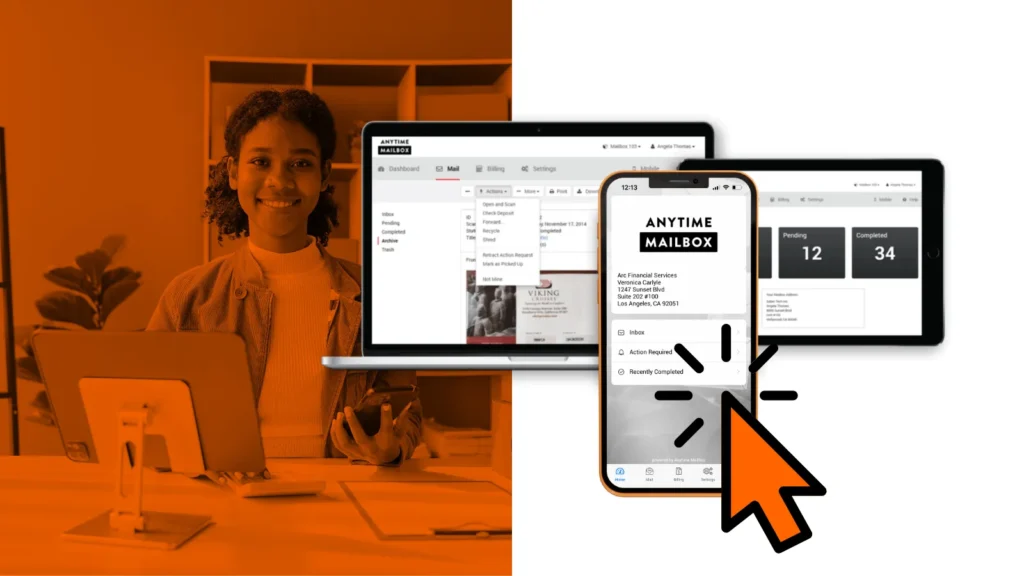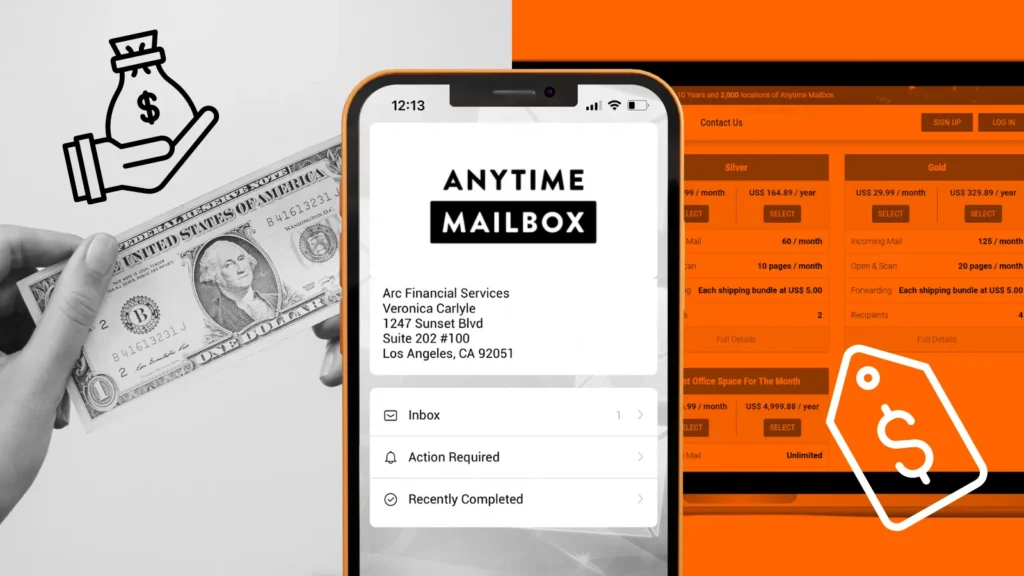Want to set up an alternate address? This guide has you covered. Whether you need a virtual mailbox, a PO Box, or an email alias, follow our step-by-step instructions on how to set up an alternate address and choose the best option for your needs and get started today.
Key Takeaways
- An alternate address, such as a PO Box or virtual mailbox, offers privacy, enhanced security, and a professional image, which are useful for both individuals and businesses.
- Setting up an alternate address involves choosing between a physical PO Box and a virtual mailbox, researching providers, and completing necessary documentation such as Form 1583 for U.S. virtual addresses.
- Virtual mailbox services offer advanced features such as mail scanning, forwarding, shredding, and check depositing, providing comprehensive mail management solutions and flexibility for users.
What is an Alternate Address?

An alternate address is a secondary mailing or email address that serves as an additional point of contact, distinct from your primary address. This concept encompasses various forms, including:
- Virtual Mailboxes
- PO Boxes
- Private Mailboxes
Each type of alternate address offers unique benefits, catering to different needs and preferences.
Alternate addresses, with their versatile attributes, prove invaluable for both individuals and businesses, as they can play multiple roles. They can be used for a multitude of purposes, from maintaining privacy and enhancing security, to presenting a more professional image.
For instance, home-based businesses often utilize alternate mailing addresses to separate personal and professional correspondence, thereby maintaining a clear boundary between work and home life. Alternate addresses are also particularly handy when a different address from the primary one is required.
Definition and Purpose

In the tangible world, alternate addresses assume multiple forms, each fulfilling distinct purposes.
PO Boxes, for instance, provide enhanced security for mail and allow individuals to receive correspondence without disclosing their residential address.
Virtual mailboxes take this a step further by offering the security benefits of a PO Box while also providing users with scanned copies of their mail online, accessible from anywhere.
They offer an alternative address for receiving mail from any carrier and safely storing deliveries, which is particularly useful for businesses needing commercial or international shipping addresses.
These various forms of alternate addresses serve to enhance privacy, security, and convenience, adapting to the diverse needs of modern communication and business practices.
Why You Might Need an Alternate Address

The motivations behind needing an alternate address vary as widely as the individuals and businesses utilizing them.
One of the primary motivations is the protection of privacy. By using an alternate address, you can keep your home address confidential, which is particularly important in an age where personal information can be easily misused.
This privacy aspect is especially crucial for entrepreneurs and home-based businesses who want to maintain a separation between their personal and professional lives.
Besides privacy, the distinction between these two areas of life promotes work-life balance, which is crucial to prevent burnout, reduces stress, and enhances overall well-being, according to WeWork.
Alternate addresses can significantly enhance a business’s professional image and credibility. Some benefits of using alternate addresses include:
- A home-based business can use a virtual mailbox service to obtain a prestigious business address, which can be more appealing to potential clients than a residential address.
- Alternate addresses are invaluable for those who travel frequently for business or cannot receive mail at their home address.
- They provide a stable mailing solution, ensuring that important correspondence is never missed, regardless of your physical location.
- Some digital mailboxes can serve as registered agents, providing physical addresses for business incorporation, which is a crucial consideration for many startups and small businesses.
How Do You Set Up an Alternate Address?

Establishing an alternate address requires a sequence of careful steps and considerations.
Step 1: Choose the type of alternate address you need
The process begins with the crucial decision of choosing between a physical PO Box and a virtual mailbox.
This choice depends on your specific needs, such as the volume of mail you expect to receive, the types of services you require, and your budget.
Step 2: Select your alternate address provider
Once you’ve decided on the type of alternate address that best suits your needs, the next step is to research and select a suitable service provider.
This involves comparing different options, reading customer reviews, and evaluating the features offered by various companies.
Step 3: Submit the proper documents
After choosing a provider, gathering the requisite documentation to finalize the registration process becomes your next task.
This preparation ensures a smooth setup experience and helps you avoid any potential delays or complications in establishing your new alternate address.
Factors to Consider When Choosing An Alternate Address Provider
There are some factors to consider when choosing the perfect provider for your needs. Weighing the pros and cons will help you narrow down your choices.
For virtual mailboxes, this often involves selecting a plan that aligns with your anticipated mail volume and service requirements.
Additionally, when selecting a location for your alternate address, factors like proximity to your primary location (if applicable) and the reputation of the address should be kept in mind.
Picking an address that aligns with your brand is beneficial. Many virtual mailbox services offer a range of locations across the US and internationally, allowing your organization to select an address that best serves your needs.
Prerequisite Conditions and Documentation

Establishing an alternate address, especially a virtual mailbox, necessitates meeting certain prerequisite conditions and submitting particular documents.
This process is designed to ensure the security and legitimacy of the service to receive and send mail on your behalf.
For U.S. virtual address accounts, after you create your account, a crucial step is filing a notarized Form 1583 with the post office. This form authorizes the service provider to receive and send mail on your behalf.
It’s important to note that some providers may charge for the notarization service, so it’s wise to inquire about this beforehand.
The verification process typically involves providing two forms of identification, which can usually be digitally uploaded for convenience. This step is essential for confirming your identity and ensuring that only authorized individuals have access to your mail.
Once your account is verified, you’re all set to start using your new virtual business address and associated services, and your clients can begin sending mail to your address just as they would any address and your correspondence will be delivered to your virtual inbox.
Remember, it’s crucial to notify your business contacts about your new mailing address and officially update it by filing a Change of Address with your local post office.
This ensures a smooth transition to your new alternate address and prevents any important mail from being lost or delayed.
Which Virtual Mailbox Should You Go For?

Choosing the best virtual mailbox service provider is a pivotal step towards establishing an efficient alternate address. This decision can significantly impact the efficiency and convenience of your mail management. When evaluating providers, it’s essential to consider factors such as:
- Cost
- Available Features
- Customer Reviews
- The provider’s reputation in the industry
One popular option in the virtual mailbox market is Anytime Mailbox, which offers services starting at $5.99 per month.
This provider is available worldwide, including in the UK and Canada, making it a versatile choice for international users. Some key features to look for in a virtual mailbox service include:
- Mail Scanning
- Mail Forwarding
- Package Acceptance
- The ability to use the address as an official business address
These services can offer significant advantages over traditional alternatives like PO Boxes, which often have limitations such as privacy concerns and restrictions on receiving packages from non-USPS carriers.
Virtual mailbox services provide a more flexible and comprehensive solution, allowing users to receive mail from any carrier, including FedEx, UPS, and DHL, which is particularly beneficial for businesses that rely on a variety of shipping services.
Virtual mailboxes offer enhanced privacy features by keeping your residential address confidential, which is crucial for individuals and businesses concerned about security.
They often come with advanced mail management features that go beyond just receiving and storing mail. Users can access their mail online from their inbox from anywhere in the world, thanks to mail scanning and digital archiving capabilities.
This means you can view, download, and organize your mail digitally, reducing the need for physical storage and making it easier to keep track of important correspondence via the provider inbox.
For businesses, virtual mailboxes can also offer a professional business address that can be used for official documentation, marketing materials, and client communications.
This can enhance your business’s credibility and help establish a presence in multiple locations without the need for physical office space.
Virtual mailbox services offer a versatile and efficient alternative to traditional PO Boxes, providing greater flexibility, enhanced privacy, and advanced mail management features that cater to the needs of both individuals and businesses.
Address Verification Process for Virtual Mailboxes
The address verification process, a vital step in establishing a virtual mailbox, ensures the security and privacy of your information.
This process involves validating and standardizing address data using specialized software or API services. The primary goal is to confirm that the address you’ve chosen is legitimate and capable of receiving mail and packages.
Reputable providers have this process complete prior to offering the address for use with virtual mailboxes. During the verification process, your available address is cross-checked against official databases or other reliable sources.
This step not only confirms the existence of the address but also ensures its deliverability. The thoroughness of this process protects both you and the service provider from potential fraud or misuse of the mailbox service.
While it may seem like an extra step, address verification is essential for maintaining the integrity of the virtual mailbox system and providing you with a secure, reliable alternate address.
Accessing and Managing Your Alternate Address

Once your alternate address gets established, its access and management become a part of your mail handling routine.
Most virtual mailbox providers offer user-friendly interfaces through both mobile and web applications, allowing you to manage your mail from anywhere, at any time.
This level of accessibility is one of the key advantages of using a virtual mailbox service over traditional recipient alternatives.
These applications typically come packed with a range of functionalities designed to make mail management as effortless as possible.
You can view scanned images of your received mail in your digital inbox, sort and categorize your correspondence, and make decisions about each piece of mail directly from the app.
Common options include forwarding mail to your physical address, requesting that certain items be opened and scanned for full content viewing, or even instructing the service to shred and recycle unwanted mail.
This level of control and flexibility ensures that you’re always on top of your incoming mail, regardless of your physical location.
Mobile and Web Apps
Mobile and web applications, central to modern virtual mailbox services, bestow multiple users with unmatched control over their mail management.
These apps typically allow users to view scanned images of incoming mail, providing a quick and easy way to stay updated on your correspondence.
Beyond simple viewing, these platforms often enable users to categorize their mail, making it easier to organize and prioritize important documents. Most applications also allow you to query your digital inbox in search of messages.
One of the most valuable features of these apps is the ability to set up notifications.
Users can receive real-time alerts when new mail arrives, ensuring that they never miss important correspondence. This instant access to information about your mail is particularly useful for time-sensitive documents or for those who need to respond quickly to business communications.
Many of these apps offer scanning services that provide instant viewing of mail contents, similar to what you experience with an email account, which is invaluable for users who require timely access to their correspondence, regardless of their physical location.
Forwarding Options
Forwarding options are a key feature of virtual mailbox services, providing flexibility in how you receive your physical mail.
Once your mail or packages arrive at your alternate address, you usually have several handling choices. These often include standard mail forwarding, express shipping, or holding the mail for pickup.
It’s as straightforward as sending an email to an alternate email address, with all commands available through the provider’s web interface or mobile application.
This variety allows you to tailor the service to your specific needs, whether you’re frequently on the move or prefer to have your mail sent to you in batches.
Many virtual mailbox services offer customizable forwarding rules, allowing you to set up automatic instructions for different types of mail.
For example, you might choose to have all personal correspondence forwarded to your home address or business-related mail scanned and emailed to you.
Forwarding to different addresses is particularly useful for businesses with several locations, or for individuals who split their time between different residences.
This level of customization ensures that your mail handling process is as efficient and convenient as possible, adapting to your lifestyle or business needs.
Handling Different Types of Mail

The handling of different types of mail can show considerable variation based on the kind of alternate address you opt for.
Traditional PO Boxes, for instance, have limitations on the types of mail they can receive. According to USPS, PO Boxes are restricted to USPS deliveries, which can be a significant drawback for those expecting packages from other carriers.
This limitation can be particularly problematic for businesses that rely on a variety of shipping services, or individuals who frequently receive packages from international sources.
In contrast, virtual mailboxes offer a more comprehensive solution, capable of accepting mail and parcels from any carrier. This flexibility is a major advantage, especially for businesses or individuals who receive a diverse range of mail types.
Virtual mailbox services can handle everything from regular letters to large parcels and even registered mail.
This capability ensures that all your mail, regardless of its source or type, can be managed through a single, convenient system. The ability to receive and process various types of mail makes virtual mailboxes a versatile choice for those seeking a comprehensive alternate address solution.
Additional Services Offered
Virtual mailbox services frequently extend beyond basic mail handling, offering an array of extra services that significantly boost the value proposition for users.
These extra features can include mail forwarding, scanning, and shredding, providing a comprehensive solution for all your mail management needs. Some providers even offer more specialized services such as check depositing, where they can send checks directly to your bank for deposit.
These additional services can be particularly beneficial for businesses or individuals who need to manage their mail efficiently while maintaining flexibility in their location or schedule.
Scanning and Shredding
Scanning and shredding services are two of the most valuable additional features offered by many virtual mailbox providers.
The scanning service allows users to receive digital copies of their physical mail, similar to how you may receive correspondence to your personal email address account, which can be accessed through the service provider’s app or web interface.
This feature is particularly useful for those who need to stay on top of their correspondence while traveling or working remotely.
Once mail arrives at the alternate address, users can choose to have it scanned and emailed to them, providing quick and easy access to important documents without the need for physical forwarding.
Shredding services offer a secure way to dispose of sensitive documents once they’re no longer needed.
Many virtual mailbox services provide the option to have physical mail shredded after it has been scanned and stored digitally.
This service ensures that confidential information is securely destroyed, providing peace of mind for users concerned about privacy and data security.
The custom combination of scanning and shredding services allows users to maintain a paperless office while still having access to all their important correspondence, striking a balance between convenience and security.
Check Depositing
Check depositing is an innovative service offered by some virtual mailbox providers that can be particularly beneficial for certain users, especially digital nomads and businesses that frequently receive check payments.
This service allows users to have checks that are received at their alternate address deposited directly into their bank account, eliminating the need to physically handle and deposit checks themselves.
The process is typically straightforward:
- When a check arrives at the virtual mailbox, the user is notified through the service’s app or web interface.
- They can then view a scanned image of the check and submit a deposit request.
- The service provider then processes the check and deposits it into the user’s specified bank account.
This feature is especially convenient for those who receive regular payments via check but prefer not to visit a bank to make deposits.
It’s worth noting that this service is particularly valuable for users who need to deposit checks to U.S. banks without being physically present in the country.
By offering check depositing, virtual mailbox services provide a comprehensive solution for managing both digital and physical financial transactions.
Costs and Pricing Tiers

When contemplating an alternate address solution, understanding the costs linked to its setup and maintenance is important.
The pricing structure for virtual mailbox services can vary significantly depending on the provider and the specific features included in each package.
Generally, providers offer different pricing tiers or packages designed to cater to various needs and budgets.
These pricing tiers typically range from basic plans that offer essential services like:
- Mail Receiving and Scanning
- Mail Storage
- Check Depositing
- Multiple User Access
When evaluating costs, it’s crucial to consider not just the monthly or annual fee, but also any additional charges for services like mail forwarding or extra storage.
Some providers might offer a pay-as-you-go model for certain services, which can be more cost-effective for users with lower mail volumes.
It’s also worth noting some providers offer a wide range of mailbox locations to choose from, with some boasting over 2,300 locations, allowing users to select an address that best suits their needs.
Summary
- Setting up an alternate address through a virtual mailbox service offers a flexible, secure, and efficient solution for managing your mail in today’s digital age.
- From enhanced privacy and professional image for businesses to convenient mail management for frequent travelers, the benefits are numerous.
- We’ve explored the various types of alternate addresses, the process of setting one up, and the key factors to consider when choosing a service provider.
- We’ve also delved into the additional services offered, such as mail scanning, shredding, and check depositing, which can significantly streamline your mail management process.
- As you consider whether an alternate address is right for you, remember to evaluate your specific needs, compare different providers, and carefully consider the costs and features offered.
- With the right virtual mailbox service, you can revolutionize the way you handle your mail, saving time and providing peace of mind, no matter where you are in the world.
Frequently Asked Questions (FAQs)
What is the main difference between a PO Box and a virtual mailbox?
- The main difference is that a PO Box is a physical box at a post office that can only receive USPS mail, whereas a virtual mailbox is a service that provides a physical address and can receive mail from any carrier, in addition to offering extra services like mail scanning and online management.
Can I use a virtual mailbox address as my business address?
- Yes, you can use a virtual mailbox address as your company business address, which is particularly useful for home-based businesses (to home addresses private) or companies seeking to establish a presence in a different location.
How secure are virtual mailbox services?
- Virtual mailbox services are generally secure, as they employ strict security measures such as address verification processes and secure online platforms. It’s crucial to select a reputable provider and follow best practices for account security.
Can I forward mail internationally with a virtual mailbox service?
- Yes, many virtual mailbox services offer international mail forwarding, but there may be additional costs and international shipping regulations to consider.
How much does a virtual mailbox service typically cost?
- Virtual mailbox services typically start at $5-10 per month for basic plans, while more comprehensive packages with additional features can cost $50 or more per month. When evaluating the cost, it’s important to compare different providers and consider your specific needs.



